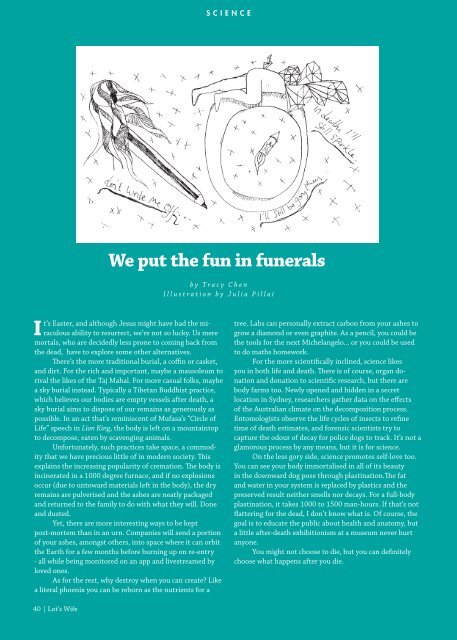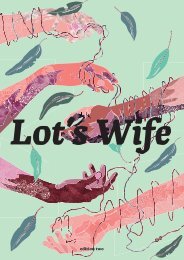Lot's Wife Edition 2 2016
Create successful ePaper yourself
Turn your PDF publications into a flip-book with our unique Google optimized e-Paper software.
SCIENCE<br />
We put the fun in funerals<br />
by Tracy Chen<br />
Illustration by Julia Pillai<br />
It’s Easter, and although Jesus might have had the miraculous<br />
ability to resurrect, we’re not so lucky. Us mere<br />
mortals, who are decidedly less prone to coming back from<br />
the dead, have to explore some other alternatives.<br />
There’s the more traditional burial, a coffin or casket,<br />
and dirt. For the rich and important, maybe a mausoleum to<br />
rival the likes of the Taj Mahal. For more casual folks, maybe<br />
a sky burial instead. Typically a Tibetan Buddhist practice,<br />
which believes our bodies are empty vessels after death, a<br />
sky burial aims to dispose of our remains as generously as<br />
possible. In an act that’s reminiscent of Mufasa’s “Circle of<br />
Life” speech in Lion King, the body is left on a mountaintop<br />
to decompose, eaten by scavenging animals.<br />
Unfortunately, such practices take space, a commodity<br />
that we have precious little of in modern society. This<br />
explains the increasing popularity of cremation. The body is<br />
incinerated in a 1000 degree furnace, and if no explosions<br />
occur (due to untoward materials left in the body), the dry<br />
remains are pulverised and the ashes are neatly packaged<br />
and returned to the family to do with what they will. Done<br />
and dusted.<br />
Yet, there are more interesting ways to be kept<br />
post-mortem than in an urn. Companies will send a portion<br />
of your ashes, amongst others, into space where it can orbit<br />
the Earth for a few months before burning up on re-entry<br />
- all while being monitored on an app and livestreamed by<br />
loved ones.<br />
As for the rest, why destroy when you can create? Like<br />
a literal phoenix you can be reborn as the nutrients for a<br />
tree. Labs can personally extract carbon from your ashes to<br />
grow a diamond or even graphite. As a pencil, you could be<br />
the tools for the next Michelangelo... or you could be used<br />
to do maths homework.<br />
For the more scientifically inclined, science likes<br />
you in both life and death. There is of course, organ donation<br />
and donation to scientific research, but there are<br />
body farms too. Newly opened and hidden in a secret<br />
location in Sydney, researchers gather data on the effects<br />
of the Australian climate on the decomposition process.<br />
Entomologists observe the life cycles of insects to refine<br />
time of death estimates, and forensic scientists try to<br />
capture the odour of decay for police dogs to track. It’s not a<br />
glamorous process by any means, but it is for science.<br />
On the less gory side, science promotes self-love too.<br />
You can see your body immortalised in all of its beauty<br />
in the downward dog pose through plastination.The fat<br />
and water in your system is replaced by plastics and the<br />
preserved result neither smells nor decays. For a full-body<br />
plastination, it takes 1000 to 1500 man-hours. If that’s not<br />
flattering for the dead, I don’t know what is. Of course, the<br />
goal is to educate the public about health and anatomy, but<br />
a little after-death exhibitionism at a museum never hurt<br />
anyone.<br />
You might not choose to die, but you can definitely<br />
choose what happens after you die.<br />
40 | Lot’s <strong>Wife</strong>

















